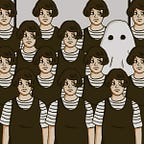Not to Be Reproduced — Art Criticism
Artist: Rene Magritte
Date: 1937
Movement: Surrealism
Medium: Oil on Canvas
Dimension: 81.3 x 65 cm
Location: Museum Boijmans Van Beuningen, Rotterdam.
Magritte’s “Not to Be Reproduced” is like nothing I’ve seen before. The painting depicts a male figure (this painting was commissioned by poet and patron, Edward James and this is considered a portrait of Edward James himself) with his back to the viewer, standing in front of a mirror in this anonymous — looking room, to provide a brief overview of it. The location itself is actually in the house of Magritte, but the atmosphere is rather neutral — and the mirror is quite unremarkable, with a plain wooden frame, it seems to be of a typical size and type. The walls’ color are a creamy brown and the fireplace is stone or marble from what we can see. A copy of Edgar Allen Poe’s book, “The Story of Arthur Gordan Pimm of Nantucket”, lies on the edge of the fireplace.
All seems absolutely routine in this setup, in reality it borders on the mundane. Yet there is a way for Magritte to invert the norm and push the mundane to absurd locations. The mirror reveals a repeated image of the back of the figure’s head, instead of the male figure’s face being mirrored back as we might expect. More confusingly, the novel accurately mirrors itself back in the mirror. In his art, Magritte produces a logic that, on the one hand, corresponds to our understanding of the universe, but disregards it by the incomplete reflection of the male figure.
Looking at this picture, at the very least, will make you double-take. Yet there is more to this painting than an optical illusion. Looking at it makes me feel uncomfortable — the truth I know has been upturned and disregarded too quickly, but to what end? I take this illustration as a note, a kind of fable: don’t take anything for granted and don’t take anything for granted. We presume what the mirror will represent, but the response we anticipate is denied to us. My point is, what we consider to be the truth might not always be the case: in terms of identification, I think the fact that the figure is reflected ‘wrongly’ is also poignant. The identity of a person is performative; we control how we behave and how we communicate with individuals. But can we really really know a person because of this subjectivity and the inconstancy of actions, or do we just get the surface impression?
What makes me question this painting is how well we will ever know a person if we only see one side of them, and by showing one side of a person in an object, the mirror, which is supposed to represent reality, Magritte demonstrates this through a visual metaphor. The book is represented correctly since it is a permanent, objective, and defined entity. Once it is written, the words in a book do not alter. In many of his paintings, Magritte deals with obscuring or hiding the face of a human. In “The Son of Man”, “The Lovers”, and “The Great War”, this technique can also be seen. I agree that unease, uncertainty, and curiosity are the main emotions that the technique evokes. A focal part of the body is the face; we know individuals from how they use their face. So this is a cause for distress when this mirror of the soul is concealed. We want to understand why the face is concealed from us — why are we not permitted to see it? Who has their face concealed? Is there something we shouldn’t see there? These questions are never answered by Magritte. He raises questions through his paintings and offers them up for the world to answer. I think he’s as much a philosopher as an artist.
When I first saw “Not to Be Reproduced”, it was also the first time I really got involved with the artwork in that kind of way. The rejection of the norm is a challenge to the viewer — in order to accept this new one, we must first understand our understanding of reality. When I first saw this painting, I must have been a teenager, and since then I’ve changed a lot — and my understanding of it shifts, much like the painting itself. It changes as I change. I don’t think I would think the same way I do today without this painting-it (and discovering Magritte) helped me see the world in a more playful, more fluid way. It taught me to realize that things are never as they seem, and that this is good: Where would the fun be in that, if things were only straightforward? I would not have had any of the subsequent experiences with the work of Magritte and his way of thought without this first experience. And that’s the beauty of the first thing: it’s not an isolated gathering, but a beautiful unfolding. At first, we know how they felt that they felt, but over time they evolved into something different. You shift and you pass, and together you transform.
Source: Wikimedia
